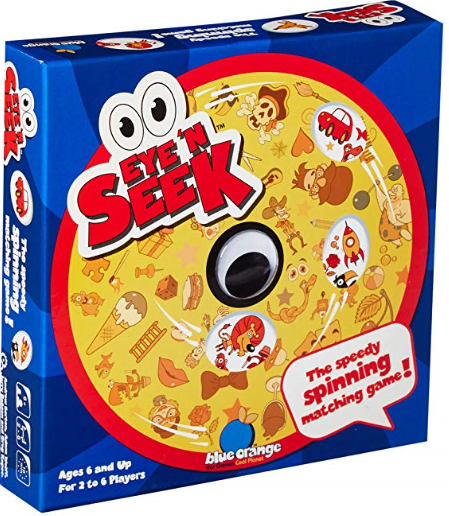
Eye 'N Seek is a figure ground game with a "twist", and six ways to play over two levels of difficulty! The big plastic eye on the front of the box is intriguing, but it's just a decoration.
The goal of the game is to find the image(s) from the picture cards faster than your opponent(s). The wheel cards measure about 6.5" x 6.5". One side of the card is green and the other side is orange. Each side is covered with small images, but also include three oval windows. You can see these windows better in the image above than in my picture below. However, there are more small images that show in the windows than in the image above, more like my picture below. Also, the windows on the orange side are bigger than the green and show more images. There is a movable circle printed with these small images inside the card. Put your finger on the side of the wheel and pull down to make the wheel inside turn and change the images you see in the oval windows.
The picture cards come in two colors, green and orange, 50 of each color. The green picture cards each show one image and will be played with on the green side of the card. The orange picture cards each show two images and will be played with on the orange side. The images may be different sizes and are generally in different orientations, but the coloring matches.
After playing a few games I realized that all the wheels are the same, meaning that the pictures for each player will be in the exact same location on the movable wheel. Using this information, I was able to sort out specific cards that I wanted the players to find in specific windows. If three windows are too many to watch, start with one window, or on the green side there are two windows that are close to the bottom. I often use that one to start and then I pick out the cards that will appear in those two windows ahead of time.
 |
| Left: Wheel card. Right: Picture card. |
- Variation 1
- Mix 18 cards and stack them in the middle.
- Give each player a wheel card.
- Players all look on their wheel card for the image on the top card. Turn the wheel as mentioned above to make the images move across the three windows. Play either all green cards, all orange cards, or a mix of the two. Player with the most cards after all 18 have been found is the winner.
- Variation 2
- Play as in variation 1, except the last person to find the image gets the card. Person with the fewest cards at the end is the winner. This variation will take longer and may have a lot of down time as you wait on other players.
- Variation 3
- Players take turns being the leader for each round. The leader looks at his card and describes one of the images in one of his windows. Don't name the item, just give description clues like it wears a hat and it lives in the snow. The first player to find a matching image on his card gets a point. First person to win five points is the winner.
- Variation 4
- Randomly choose 6 cards and place them in a line so that all players can see them all. Use either all green cards, all orange or a mix. Players race to find images from the cards. When a player finds an image, they take the card. Do this three times, making a total of 18 cards. Player with the most cards at the end is the winner.
- Variation 5
- Players take turns being the leader for each round. The leader will look at his card and pick out any one image. They will tell the first letter of the image they are looking at. The first player to find any image that starts with the same letter wins a point. First player to earn five points is the winner.
- Variation 6
- Players take turns being the leader for each round. The leader will look at his card and pick out any one image. They will give a word that rhymes with the picture. The first player to find any image that rhymes with the leaders word gets a point. First player to win five points wins the game.
Try this:
- Model how to hold coordinate holding the card and turning the wheel.
- Start by finding pictures on the big circle on the front of the card, without turning the wheel and looking in the windows. You will have to go through the cards ahead of time and pick out the matches because not all of the images are shown.
- Put more than one card out to look for and try to keep several items in mind at the same time.
- Choose one item to look for on the orange side. Once you find that item, then look in the other windows to see if you can find the match, turning the wheel slowly so that the first item does not disappear from its window. Sometimes there are two of an item so that once you find the first item, the second item will not necessarily show up in another window. Just keep looking.
Work
on visual discrimination, figure ground, visual form constancy, visual
scanning, eye-hand coordination, manual dexterity, two-handed activity,
executive functioning skills, process skills, socialization skills, play
and leisure exploration and participation
In the box: 6 double-sided wheels, 100 picture cards
If you are interested in purchasing this game or just want more information, click on the image below.








